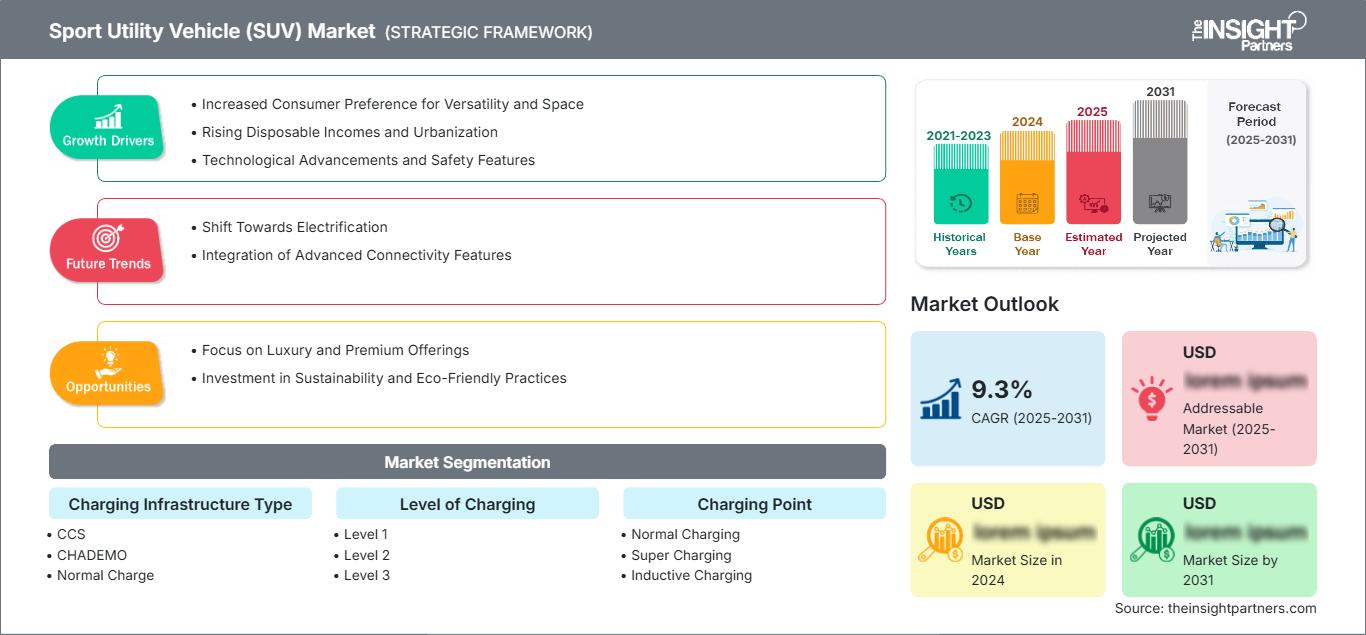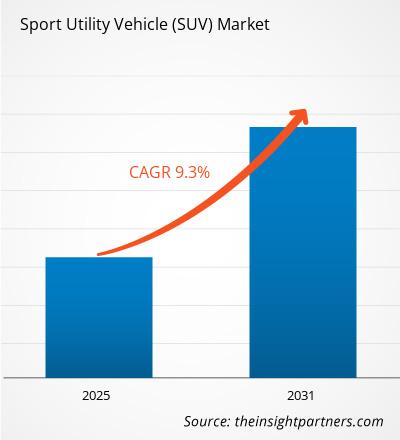Der Markt für Sport Utility Vehicles (SUV) wird voraussichtlich zwischen 2025 und 2031 eine durchschnittliche jährliche Wachstumsrate (CAGR) von 9,3 % verzeichnen, wobei die Marktgröße von XX Millionen US-Dollar im Jahr 2024 auf XX Millionen US-Dollar im Jahr 2031 anwachsen wird.
Der Bericht ist segmentiert nach Ladeinfrastrukturtyp (CCS, CHADEMO, Normalladung, Tesla Super Charger, Typ 2 (IEC 62196 und GB/T 20234)); Ladestufe (Stufe 1 (weniger als 3,7 KW), Stufe 2 (3,7 – 22 KW), Stufe 3 (über 22 KW)); Ladepunkt (Normalladung, Superladung, induktive Ladung); DC-Schnellladung (Schnellladung, ultraschnelle Ladung); Installationstyp (tragbares Ladegerät, festes Ladegerät). Die globale Analyse ist weiter auf regionaler Ebene und nach den wichtigsten Ländern aufgeschlüsselt. Der Bericht bietet den Wert in USD für die oben genannte Analyse und Segmente.
Zweck des Berichts
Der Bericht „Sport Utility Vehicle (SUV) Market“ von The Insight Partners zielt darauf ab, die aktuelle Landschaft und das zukünftige Wachstum sowie die wichtigsten treibenden Faktoren, Herausforderungen und Chancen zu beschreiben. Dadurch werden verschiedenen Geschäftspartnern Erkenntnisse vermittelt, wie z. B.:
- Technologieanbieter/-hersteller: Um die sich entwickelnde Marktdynamik zu verstehen und die potenziellen Wachstumschancen zu kennen, damit sie fundierte strategische Entscheidungen treffen können.
- Investoren: Um eine umfassende Trendanalyse hinsichtlich der Marktwachstumsrate, der finanziellen Marktprognosen und der Chancen entlang der Wertschöpfungskette durchzuführen.
- Regulierungsbehörden: Um Richtlinien und Überwachungsaktivitäten auf dem Markt zu regulieren, mit dem Ziel, Missbrauch zu minimieren, das Vertrauen der Investoren zu wahren und die Integrität und Stabilität des Marktes aufrechtzuerhalten.
Marktsegmentierung für Sport Utility Vehicles (SUV) Ladeinfrastrukturtyp
- CCS
- CHADEMO
- Normalladung
- Tesla Super Charger
- Typ 2
Ladestufe
- Stufe 1
- Stufe 2
- Stufe 3
Ladepunkt
- Normales Laden
- Super-Laden
- Induktives Laden
Installationstyp
- Tragbares Ladegerät
- Festes Ladegerät
DC-Schnellladen
- Schnellladen
- Ultra-Schnellladen
Sie erhalten kostenlos Anpassungen an jedem Bericht, einschließlich Teilen dieses Berichts oder einer Analyse auf Länderebene, eines Excel-Datenpakets sowie tolle Angebote und Rabatte für Start-ups und Universitäten.
Markt für Sport Utility Vehicles (SUV): Strategische Einblicke

- Holen Sie sich die wichtigsten Markttrends aus diesem Bericht.Dieses KOSTENLOSE Beispiel umfasst Datenanalysen, die von Markttrends bis hin zu Schätzungen und Prognosen reichen.
Wachstumstreiber für den Markt für Sport Utility Vehicles (SUVs)
- Steigende Vorliebe der Verbraucher für Vielseitigkeit und Platz: Einer der Haupttreiber des SUV-Marktes ist die wachsende Vorliebe der Verbraucher für Fahrzeuge, die Vielseitigkeit, viel Platz und Komfort bieten. SUVs bieten eine höhere Sitzposition, geräumige Innenräume und die Möglichkeit, sowohl Passagiere als auch Fracht problemlos zu transportieren. Diese Vielseitigkeit spricht Familien, Abenteuerlustige und Pendler in der Stadt gleichermaßen an und führt zu einer erhöhten Nachfrage nach kompakten und großen SUVs.
- Steigendes verfügbares Einkommen und Urbanisierung: Mit steigendem verfügbaren Einkommen, insbesondere in Schwellenländern, können sich mehr Verbraucher SUVs leisten, die oft als Premiumfahrzeuge angesehen werden. Die Urbanisierung treibt diesen Trend ebenfalls voran, da immer mehr Menschen mit Familien in die Städte ziehen und Fahrzeuge suchen, die ihren Lebensstilanforderungen gerecht werden. Im städtischen Umfeld werden SUVs wegen ihrer Größe bevorzugt, die eine bessere Sichtbarkeit und eine imposante Präsenz auf der Straße ermöglicht.
- Technologische Fortschritte und Sicherheitsmerkmale: Der SUV-Markt profitiert von bedeutenden Fortschritten in der Automobiltechnologie, darunter verbesserte Sicherheitsmerkmale, Kraftstoffeffizienz und Infotainmentsysteme. Funktionen wie Fahrerassistenzsysteme (ADAS), adaptive Geschwindigkeitsregelung und verbesserte Kraftstoffeffizienz gehören zunehmend zur Standardausstattung moderner SUVs. Diese Innovationen verbessern nicht nur das Fahrerlebnis, sondern berücksichtigen auch Sicherheitsaspekte und machen SUVs für Verbraucher attraktiver.
Zukünftige Trends im Markt für Sport Utility Vehicles (SUVs)
- Verschiebung hin zur Elektrifizierung: Es gibt einen starken Trend zur Elektrifizierung von SUVs, wobei die Hersteller zunehmend Hybrid- und vollelektrische Modelle anbieten. Dieser Wandel wird durch die Nachfrage der Verbraucher nach nachhaltigeren Transportmöglichkeiten und strengeren Emissionsvorschriften in vielen Regionen vorangetrieben. Elektro-SUVs bieten die gleiche Vielseitigkeit und das gleiche Platzangebot wie herkömmliche Modelle und reduzieren gleichzeitig die Umweltbelastung. Die Einführung von Elektro-SUVs erweitert den Markt und spricht umweltbewusste Verbraucher an.
- Integration fortschrittlicher Konnektivitätsfunktionen: Die Integration fortschrittlicher Konnektivitätsfunktionen in SUVs entwickelt sich zu einem wichtigen Trend. Verbraucher erwarten von ihren Fahrzeugen zunehmend Smartphone-Integration, Navigation und Echtzeit-Datenzugriff. Funktionen wie WLAN, Spracherkennung und App-Konnektivität gehören bei vielen SUVs zum Standard, verbessern das Fahrerlebnis und sorgen dafür, dass die Insassen während der Fahrt vernetzt bleiben.
Marktchancen für Sport Utility Vehicles (SUVs)
- Fokus auf Luxus- und Premiumangebote: Der SUV-Markt erlebt einen Trend zu Luxus- und Premiumangeboten, da Verbraucher High-End-Funktionen und Komfort in ihren Fahrzeugen suchen. Die Automobilhersteller reagieren darauf mit der Einführung von Premium-SUV-Modellen, die mit modernen Materialien, Hightech-Funktionen und überlegener Leistung ausgestattet sind. Dieser Trend spiegelt die steigenden Luxuserwartungen der Verbraucher im SUV-Segment wider und führt zu einem verstärkten Wettbewerb zwischen den Herstellern.
- Investitionen in Nachhaltigkeit und umweltfreundliche Verfahren: Da die Verbraucher umweltbewusster werden, bietet sich für SUV-Hersteller die Möglichkeit, in nachhaltige Verfahren und umweltfreundliche Technologien zu investieren. Dazu gehören die Verwendung recycelbarer Materialien, die Reduzierung von Produktionsabfällen und die Entwicklung effizienterer Herstellungsverfahren. Indem sie sich als umweltbewusste Marken positionieren, können Hersteller umweltbewusste Verbraucher ansprechen und ihr Markenimage in einem wettbewerbsintensiven Markt verbessern.
Regionale Einblicke in den Markt für Sport Utility Vehicles (SUV)
Die Analysten von The Insight Partners haben die regionalen Trends und Faktoren, die den Markt für Sport Utility Vehicles (SUVs) im Prognosezeitraum beeinflussen, ausführlich erläutert. In diesem Abschnitt werden auch die Marktsegmente und die geografische Lage von Sport Utility Vehicles (SUVs) in Nordamerika, Europa, im asiatisch-pazifischen Raum, im Nahen Osten und Afrika sowie in Süd- und Mittelamerika erörtert.
Umfang des Marktberichts zum Sport Utility Vehicle (SUV)
| Berichtsattribut | Einzelheiten |
|---|---|
| Marktgröße in 2024 | US$ XX million |
| Marktgröße nach 2031 | US$ XX Million |
| Globale CAGR (2025 - 2031) | 9.3% |
| Historische Daten | 2021-2023 |
| Prognosezeitraum | 2025-2031 |
| Abgedeckte Segmente |
By Ladeinfrastrukturtyp
|
| Abgedeckte Regionen und Länder | Nordamerika
|
| Marktführer und wichtige Unternehmensprofile |
|
Dichte der Marktteilnehmer im Bereich Sport Utility Vehicles (SUV): Verständnis ihrer Auswirkungen auf die Geschäftsdynamik
Der Markt für Sport Utility Vehicles (SUVs) wächst rasant. Die steigende Nachfrage der Endverbraucher ist auf Faktoren wie veränderte Verbraucherpräferenzen, technologische Fortschritte und ein stärkeres Bewusstsein für die Produktvorteile zurückzuführen. Mit der steigenden Nachfrage erweitern Unternehmen ihr Angebot, entwickeln Innovationen, um den Bedürfnissen der Verbraucher gerecht zu werden, und nutzen neue Trends, was das Marktwachstum weiter ankurbelt.

- Holen Sie sich die Markt für Sport Utility Vehicles (SUV) Übersicht der wichtigsten Akteure
Wichtige Verkaufsargumente
- Umfassende Abdeckung: Der Bericht analysiert umfassend Produkte, Dienstleistungen, Typen und Endnutzer des SUV-Marktes und bietet einen ganzheitlichen Überblick.
- Expertenanalyse: Der Bericht basiert auf den umfassenden Erkenntnissen von Branchenexperten und Analysten.
- Aktuelle Informationen: Der Bericht ist geschäftsrelevant, da er aktuelle Informationen und Datentrends abdeckt.
- Anpassungsoptionen: Dieser Bericht kann an spezifische Kundenanforderungen angepasst werden und passt sich optimal an die Geschäftsstrategien an.
Der Forschungsbericht zum SUV-Markt kann daher dazu beitragen, die Branchensituation und die Wachstumsaussichten zu entschlüsseln und zu verstehen. Obwohl es einige berechtigte Bedenken geben kann, überwiegen die Vorteile dieses Berichts tendenziell die Nachteile.
- Historische Analyse (2 Jahre), Basisjahr, Prognose (7 Jahre) mit CAGR
- PEST- und SWOT-Analyse
- Marktgröße Wert/Volumen – Global, Regional, Land
- Branchen- und Wettbewerbslandschaft
- Excel-Datensatz
Aktuelle Berichte
Erfahrungsberichte
Grund zum Kauf
- Fundierte Entscheidungsfindung
- Marktdynamik verstehen
- Wettbewerbsanalyse
- Kundeneinblicke
- Marktprognosen
- Risikominimierung
- Strategische Planung
- Investitionsbegründung
- Identifizierung neuer Märkte
- Verbesserung von Marketingstrategien
- Steigerung der Betriebseffizienz
- Anpassung an regulatorische Trends






















 Kostenlose Probe anfordern für - Markt für Sport Utility Vehicles (SUV)
Kostenlose Probe anfordern für - Markt für Sport Utility Vehicles (SUV)